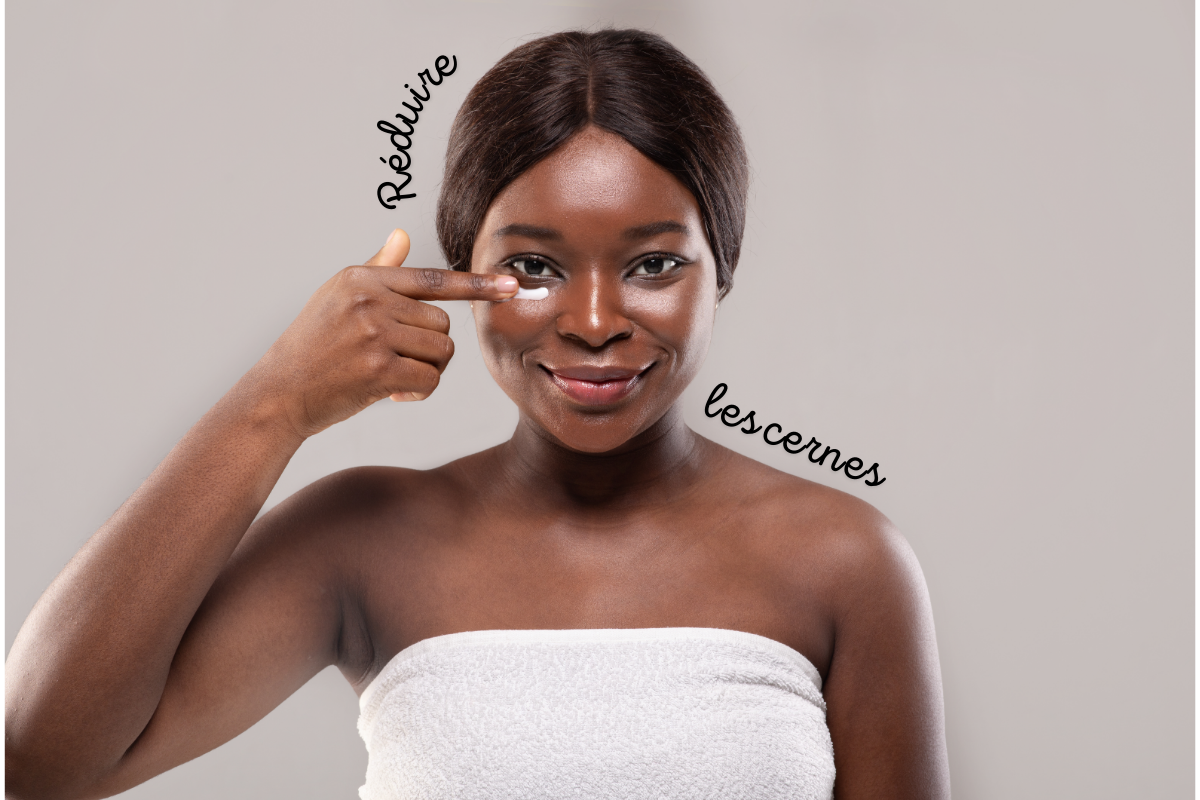Fatigue, heredity, a sign of old age… There are many causes for the appearance of dark circles. But what exactly are dark circles? Where do they come from? Is it linked solely to tiredness, or are there other reasons why they form? And above all, what are the different types and how can you get rid of them? Do you have dark circles under your eyes that make you look tired all the time? Did you know that there are different types? Dark circles can be caused by a variety of factors, including fatigue, heredity, ageing or a poor lifestyle. Fortunately, there are ways of treating and preventing them. In this article, we’ll explain the different types of dark circles, their causes and how to treat them. Follow our advice for a fresh, healthy look.
What are dark circles?
First of all, it’s important to know that the appearance of dark circles under the eyes is a normal phenomenon. This is mainly due to the fact that the epidermis under the eyeballs is 4 times thinner than that on the rest of the body. However, depending on the individual and his or her health, there are different forms. Some people have bags under their eyes, while others have hollows, and the colour of dark circles varies from one person to another. Where does this diversity come from? There are several causes: problems with tissue drainage, fatigue, heredity, poor lifestyle, etc
The appearance of dark circles is a normal phenomenon resulting from the thinness of the skin under the eyes. However, there are different types of dark circles that vary from person to person. Blue or purplish dark circles are due to the colour of the oxygen-depleted blood circulating in the veins under the lower eyelid. Hollow circles are caused by the natural ageing of the skin, which loses its suppleness and elasticity, resulting in a loss of volume under the eyes. Finally, full circles appear as a result of the melting of periorbital fat, the pocket of fat that protects the eye.
Why do I have dark circles under my eyes?
Dark circles under the eyes are a common phenomenon that can affect anyone, regardless of age or sex. They appear as a darker colour or discolouration under the eyes, often giving a tired or aged appearance. The skin under the eyes is particularly thin and delicate, making this area more susceptible to visible changes linked to a variety of factors.
There are many causes of dark circles, which can be divided into several categories. One of the main causes is pigmentation. In some cases, dark circles are caused by an increase in melanin, the pigment that gives skin its colour. This hyperpigmentation can be influenced by genetic or ethnic factors, or by exposure to the sun.
Another frequent cause is linked to vascularisation. The thin skin under the eyes can sometimes show blood vessels, giving a bluish or purplish colouration. This appearance can be exacerbated by various factors such as fatigue, lack of sleep, stress or even allergies.
It’s also important to note that dark circles can be a sign of natural ageing. With age, the skin loses its elasticity and thickness, making subcutaneous blood vessels more visible.
What factors aggravate the appearance of dark circles?
A number of lifestyle and environmental factors can influence the appearance and severity of dark circles. Lack of sleep is one of the best-known factors. Insufficient sleep can lead to pale skin, making blood vessels more visible under the skin.
Dehydration is another important factor. Insufficient water intake can make the skin under the eyes deeper and darker. Diet also plays a role, as an unbalanced diet or a lack of certain nutrients can affect skin health.
Sun exposure can worsen dark circles by increasing melanin production in the skin, especially if it is not protected by a suitable sunscreen.
Genetic factors should also not be overlooked. In some families, dark circles are more frequent and may appear earlier in life.
Finally, allergies and dermatological conditions can also play a role in the appearance of dark circles. Allergic reactions can cause inflammation and swelling under the eyes, exacerbating the appearance of dark circles.
It is important to note that dark circles can sometimes be a symptom of an underlying medical condition. In such cases, it is advisable to consult a healthcare professional for a proper diagnosis and treatment. Hence the importance of taking appropriate treatment or food supplements to manage allergies.
The impact of lifestyle on dark circles
Lifestyle plays a crucial role in the appearance and severity of dark circles under the eyes. Daily habits that are often neglected can contribute significantly to their development.
- Insufficient sleep: Sleep deprivation is one of the most common causes of dark circles. Lack of sleep can lead to a pale complexion, making dark circles more visible. In addition, lack of rest can cause fluid to accumulate under the eyes, creating a puffy appearance.
- Diet and hydration: An unbalanced diet, low in essential nutrients, can affect skin health. Similarly, dehydration can cause the skin under the eyes to become hollow and accentuate dark circles. A diet rich in fruit and vegetables, as well as adequate hydration, are essential for maintaining healthy skin.
- Sun exposure: Excessive sun exposure can aggravate dark circles by stimulating melanin production, which can accentuate hyperpigmentation under the eyes.
- Stress and fatigue: Stress and chronic fatigue can also contribute to the appearance of dark circles, due to the impact of stress on blood circulation and skin health.
How are blue or purplish under-eye circles treated?
Blue or purplish dark circles are formed on the thin, transparent skin of the lower eyelids. Their colour comes from the blue of the oxygen-depleted blood circulating in the veins under the eyelid. The intensity of the colour differs according to the thinness of each individual’s skin. Some people will have blue circles, while others will have purple circles.
There is no cure as such, since the visibility of blue or purple circles depends on the characteristics of each person’s skin tissue. That said, a good night’s sleep every day (7-8 hours) will help to prevent the colour from becoming more pronounced. In fact, when the eyes are tired, the venous network dilates and intensifies the bluish tint under the eyeballs.
How can the appearance of dark circles be improved?
Hollow circles are the result of natural ageing of the skin. As we age, the epidermis loses its suppleness and elasticity. As a result, the fat and muscles under the eyes pull it downwards, due in particular to gravity. This results in a loss of volume and creates a V-shaped hollow on the lower eyelid.
This can be treated with cosmetic surgery, in this case lipostructure or lipofilling. But you can also turn to the injection of a filling product such as hyaluronic acid , which fills the lack of volume in dark circles.
Dark circles or “bags under the eyes
Like hollow circles, full circles also come with age. However, they appear as a result of the melting of periorbital fat, the pocket of fat that protects the eye. Drawn downwards – again due to gravity – this fat settles in the lower eyelid, creating the familiar under-eye bags .
NB: Full bags under the eyes are not the same as puffy bags in the morning. The latter are in fact the result of insufficient lymphatic and venous drainage during the night. This can be caused by a lack of sleep, fatigue, or smoking and/or alcohol consumption.
How can they be treated?
Adopting a healthy lifestyle, free from tobacco and alcohol, can reduce the appearance of dark circles. Cosmetic surgery (lower blepharoplasty) can also be used to remove excess fat under the lower eyelid. The use of anti-puffiness cosmetic products is also a solution that should not be ruled out for a more convincing result.
How can I reduce the appearance of dark or grey circles?
Brown or grey circles, also known as pigmentation circles, are caused by hyperpigmentation of the skin. They are often linked to excessive exposure to the sun or premature skin ageing. Excessive melanin production can lead to the formation of brown or grey spots, giving the appearance of dark circles.
Dark circles can be treated with depigmenting creams containing ingredients such askojic acid orhydroquinone. However, it is important to be careful not to aggravate the situation by using products that may be too aggressive for the sensitive skin around the eyes. It’s also important to protect the skin from the sun with sunscreen to prevent the reappearance of brown or grey circles.
Other tips for combating dark circles
As well as specific treatments for each type of dark circles, there are some general tips for preventing or reducing their appearance. First of all, it’s important to moisturise the skin around the eyes with a suitable moisturiser. In addition, it’s important to maintain a healthy lifestyle by getting enough exercise, getting enough sleep and avoiding bad habits such as smoking and excessive alcohol consumption.
It is also important to protect your eyes from fatigue by avoiding overloading them, particularly by using computer screens or smartphones for long periods. Finally, it may be useful to use patches or natural remedies such as cold compresses made from cucumber or green tea to soothe the skin and reduce the appearance of dark circles.
How to prevent the appearance of dark circles:
To prevent the appearance of dark circles, it’s important to adopt healthy lifestyle habits and look after your skin:
- Sleep Hygiene: Making sure you get enough quality sleep is essential. We recommend aiming for 7 to 8 hours’ sleep a night.
- Sun Protection: Using specific sun protection for the eye area can help prevent hyperpigmentation caused by UV rays.
- Hydration and Nutrition: Drinking enough water and maintaining a balanced diet rich in antioxidants, vitamins and minerals is beneficial for skin health.
- Stress management: Relaxation techniques such as meditation or yoga can help reduce stress and its impact on the appearance of dark circles. In addition, nutritional supplements designed to calm the nervous system may be an option to consider.
- Skin care: Using the right cosmetic products, such as moisturisers and products containing vitamins C and K, can help reduce the appearance of dark circles.
In conclusion, although dark circles can be influenced by genetic factors and medical conditions, there are many preventative lifestyle strategies that can be adopted to reduce their appearance and intensity. For more personalised and specific advice, it is advisable to consult a dermatologist or healthcare professional.
References
- https://pubmed.ncbi.nlm.nih.gov/34235719/
- https://pubmed.ncbi.nlm.nih.gov/37236709/
- https://www.mdpi.com/1420-3049/28/12/4839
- https://academic.oup.com/asj/article/23/3/221/253814
- J Cosmet Laser Ther . 2020 Nov 16;22(6-8):217-225. doi: 10.1080/14764172.2021.1899238. Epub 2021 Jun 3.
Periorbital Discolouration Diagnosis and Treatment: Evidence-Based Review - Skin Res Technol. 2016 Aug;22(3):276-83. doi: 10.1111/srt.12258. Epub 2015 Sep 8.
Classification by causes of dark circles and appropriate evaluation method of dark circles







